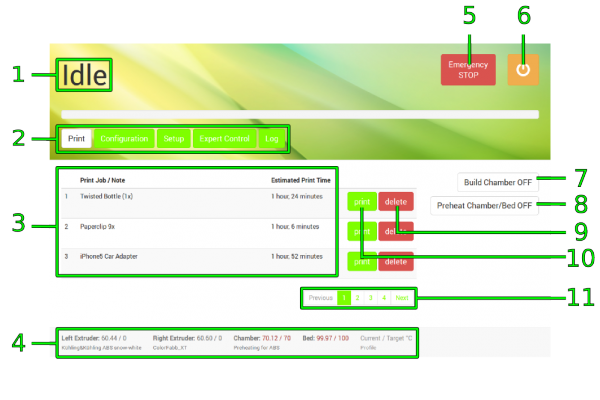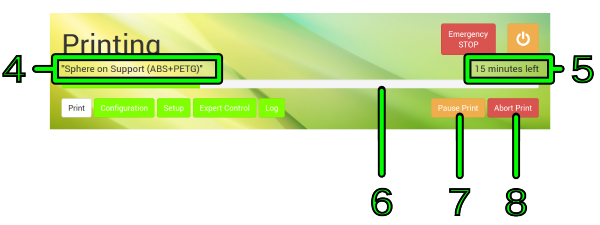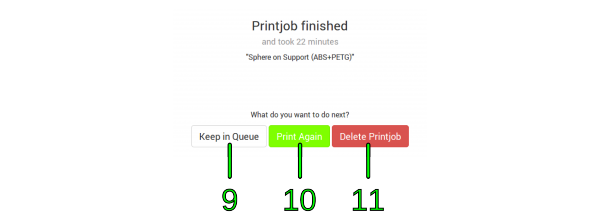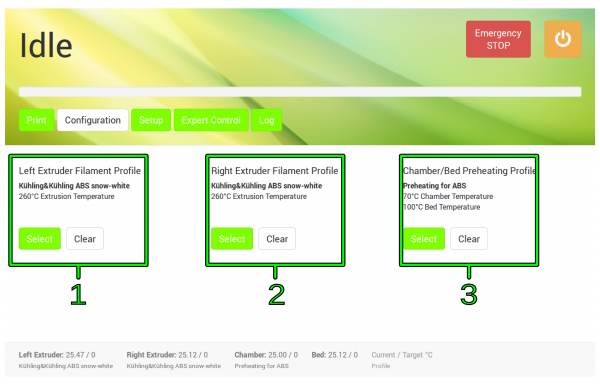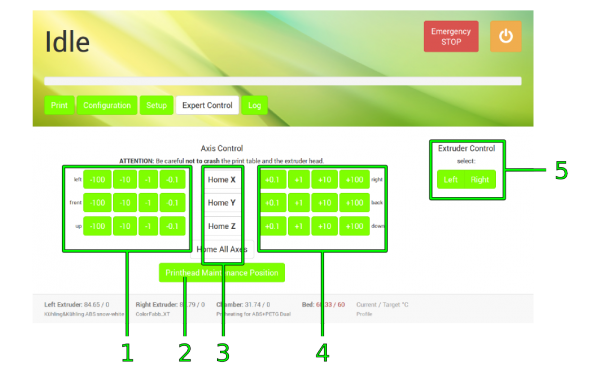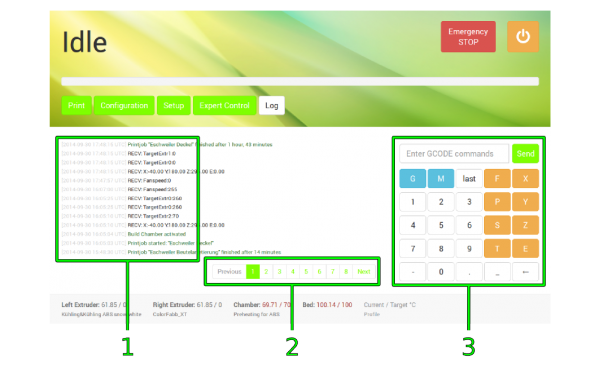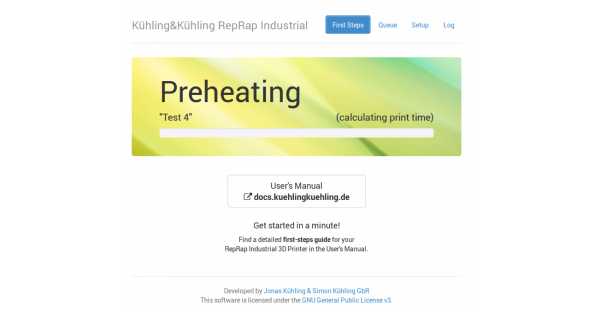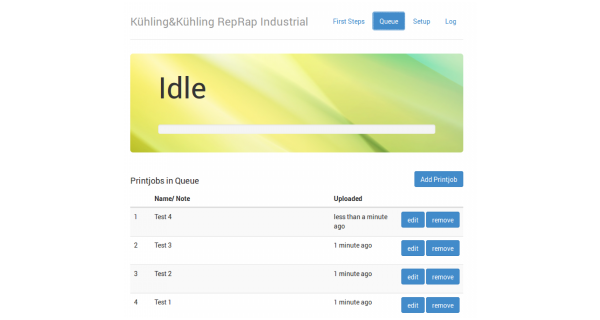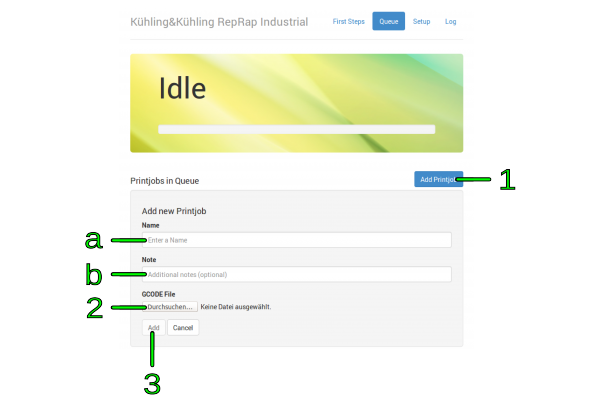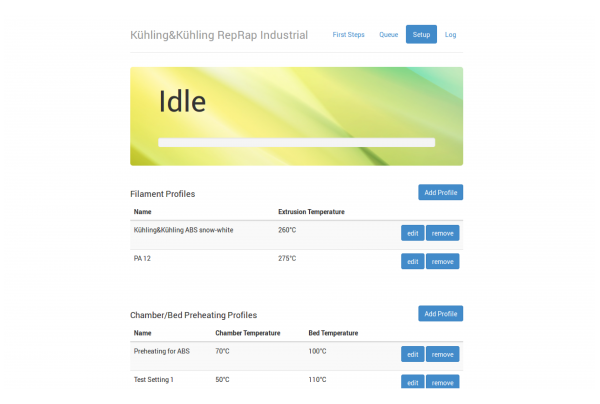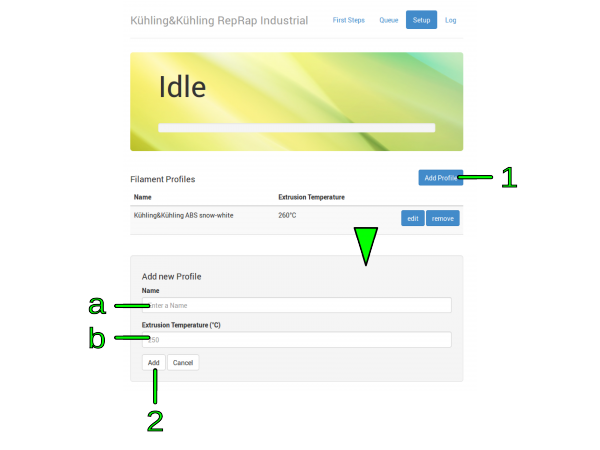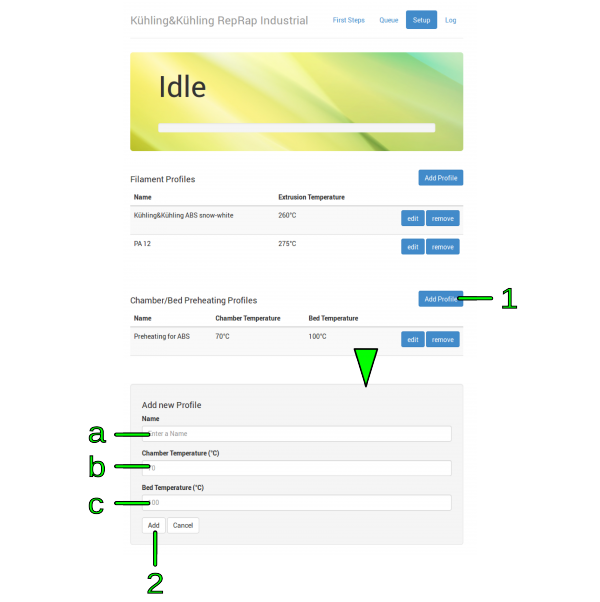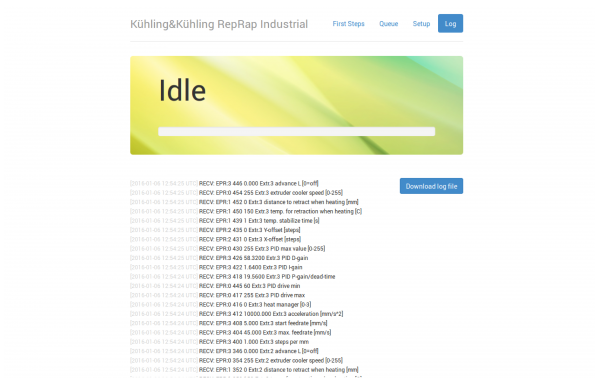Table of Contents
Operation
This manual describes the initial commissioning of the machine after installation, the operation via the RepRapOnRails operating software and all manual operating tasks that must be performed during normal day-today use.
Starting the machine
There are two possible states from which to start the machine: “switched off” and in “standby”. Either way starting the machine is a one-button-only procedure. After the boot sequence the operating screen starts with the Print screen in IDLE mode.
Switching on
If the machine is switched off via the main switch at the rear cover (position <0>) toggle the switch to <I> (ON).
The VP75 will boot automatically.
It may take a few minutes until the touchscreen has fully loaded the operating screen - wait patiently without interfering.
The first screen will be the Print screen with the (empty) print-job queue and the top-left status message displaying Idle.
Waking from standby
If the machine has been shut down via the touchscreen and set into standby mode (see section Print screen), press the wake button. The light ring of the button lights up and the machine boots automatically.
Graphical User Interface (GUI)
The start-up Print screen provides all basic operating functions.
The Configuration menu enables the operator to preselect temperature profiles for the extruders and the print bed and build chamber more directly which simplifies preheating and priming according to current needs.
Setup offers system information.
More advanced features such as program-independent operation of the axes can be found on the Expert control screen which also provides direct setting of the extruder temperatures and test extrusion.
The Log menu contains the history of machine code input and output as well as the keyboard for direct input of operating instructions.
The following paragraphs provide detailed information of the software's operating screens and explain the specific functions.
Additional information for the preparation of print jobs can be found in Tips and tricks and the manual of the slicing software.
[Print] screen
After starting the VP75 Print screen will appear as the start-up screen. Here you activate the machine and start the manufacturing process of previously uploaded part data to the queue via the web interface.
| No. | Description | Content/Function |
|---|---|---|
| 1 | Status message | Idle: machine is waiting for next user input Printing: machine is busy printing |
| 2 | Menu tabs | Select the operating menu and mode: Print redirects to the main production mode Configuration allows choosing material based temperature profiles for each extruder and bed/chamber Setup provides system information Expert Control provides access to motor controls and direct temperature settings Log represents the communication history of the control board |
| 3 | Queue | List of uploaded part data sorted by time/date (oldest first); estimated time required for processing the respective part. |
| 4 | Temperature/profile overview | Displays current and set temperature of extruder, build plate and build chamber as well as the selected material profile (see Configuration). Temperatures colored red are set and currently being actuated. |
| 5 | [Emergency STOP] button | see also → Emergency stop → Safety information in the Manual |
| 6 | [Shut-down] button | Tap to shut down the machine properly. |
| 7 | [Build Chamber ON/OFF] button | Tap to activate/deactivate drives and heaters after start-up. |
| 8 | [Preheat Chamber/Bed ON/OFF] button | Tap to activate/deactivate preheating of the build chamber/print bed according to the settings made under Configuration. |
| 9 | [delete] button | Tap to delete the respective part data from the queue. |
| 10 | [print] button | Tap to start processing the respective part data. |
| 11 | Browse buttons | Use [Previous], [Next] and [page number] to browse the part data list. |
Starting the manufacturing process
Tap the [print] button next to a part data set in the queue to start the process. You will be asked to confirm that all preparations have been performed. Tap [OK, Start Print] to definitely begin processing or [Cancel] to return to the queue.
| No. | Description | Content/Function |
|---|---|---|
| 1 | Checklist | Please make sure that all displayed requirements have been met before proceeding. |
| 2 | [OK, Start Print] button | If all preparations have been made, tap to proceed. |
| 3 | [Cancel] button | Tap to abort if any requirements has not been met. |
After confirmation the VP75 starts processing the part and the status message changes to Printing. All other menus are deactivated during a manufacturing. The part data name, the current progress, and the estimated time remaining are displayed and the [Abort Print] button is active.
| No. | Description | Content/Function |
|---|---|---|
| 4 | Part specification | The name of the G-code file uploaded to the queue. |
| 5 | Countdown | Displays the estimated remaining time (calculated from the G-code). |
| 6 | Progress bar | Indicates the progress graphically. |
| 7 | [Pause/Resume Print] button | Allows interrupting a process for interference and subsequent resumption. |
| 8 | [Abort Print] button | Tap to abort a process irreversibly. |
Pause function
The pause function was built in for the case that a print job needs to be interrupted and later resumed for other reasons than “out-of-filament” (see below).
After tapping the [Pause Print] button, the printer keeps printing until the cache is empty. This may take a few minutes, according to the complexity of the current g-code. Afterwards, the print bed is lowered into its home position, the extruders are turned off and the print head moves to the maintenance position.
Now you have access to the Expert Controls and some of the Setup functions to adjust whatever might be necessary.
To continue printing tap [Resume Print] (replaced [Pause Print]). Print bed and extruder head move to their last position and after re-heating the extruders the print seamlessly continues.
Finishing a manufacturing process
There are two ways to finish the manufacturing process: automatic finish after completion or abortion by the operator.
After regularly completing a manufacturing process all axes are moved to their home position and the extruder heating is switched off.
If you need to abort a process because the outcome does not meet expectations for example or mechanical problems appear during the process, tap the [Abort Print] button. The system will then execute the last G-code information from cash and afterwards move the extruder head to its home positions.
Either way, the VP75 returns to idle mode and displays a status message and a request how you wish to continue. Simply tap the respective button on the screen to proceed.
After standstill of all drives you can remove the build plate and take off the model.
Switching the machine off
NOTICE
Switch off the machine via the power button without turning it into standby may cause damage of the heating elements and neighboring components due to residual heat.
The cool-down performed during shut-down ensures that the fans are only switched off after the heating elements could shed all residual heat.
For switching the VP75 into standby tap the shut-down button. The system will then perform the cool-down sequence for safety reasons before deactivating the preheating and the build chamber.
The VP75 is in standby mode when:
- the screen turns black,
- the illuminated ring of the wake button dims,
- the build chamber lighting switches off.
To wake the machine from standby see Starting the 3D Printer.
For completely shutting down the VP75, perform the procedure described above and set the main switch at the rear cover to <0> (OFF) afterwards. The VP75 is now powered off and the green status indicators of the limit switches darken.
To reactivate the VP75 see Starting the machine.
INFO
For day-to-day use, the power supply should stay connected to mains power (main switch in position <I> (ON).
Emergency stop
NOTICE
The emergency stop function does not provide a cool down sequence. Do not use the emergency stop button to abort current print jobs, as this may lead to damage of the VP75 due to uncontrolled heat accumulation. Do not use the main switch as an emergency stop button. You risk loosing or corrupting data.
When the emergency stop is triggered:
- The microcontroller board is reset, all movement of the axes stops, lights, heaters and fans are turned off. The status indicator displays
Emergency Stop!. - After a few seconds the microcontroller returns to
Idlestate.
The VP75 now is in a safe state for troubleshooting.
For repairing any defects of the electronic equipment or major mechanical damages shut down the machine completely:
- Open the Print screen.
- Shut down the machine by tapping the [Shutdown] button and switching off the main switch (<0> position) after the shutdown procedure has been finished.
NOTICE
Before restarting or reactivating the machine:
- Make sure that the axes are in no collision position.
- Make sure that the reason for the emergency stop has been detected and fixed, before resuming production.
After troubleshooting or if the reason for the emergency stop was minor and you want to continue production:
- Remove the build plate from the build chamber and replace or clean it before further use.
- Restart the machine (if necessary).
- Open the Print screen.
- Switch on the build chamber. The machine will run the homing routine.
- You can now resume normal operation.
[Configuration] screen
The Configuration menu enables you to preselect material-specific temperature profiles for the extruder and, in combination, the build plate/build chamber. The latter was developed to make preheating more precise with regard to different material settings. The according profiles can be set up at the web interface setup menu.
| No. | Description | Content/Function |
|---|---|---|
| 1 | Left extruder profile selection | The currently selected profile is displayed. Tap [Select] to open the list of available filament profiles or [Clear] to delete the active profile. |
| 2 | Right extruder profile selection | |
| 3 | Bed/chamber profile selection | The currently selected profile is displayed. Tap [Select] to open the list of available filament profiles or [Clear] to delete the active profile. After selection of a profile, deactivate the preheating function in the Print menu (touch button no. 8) and activate it by tapping the button again to apply the settings. |
After opening the list, tap [Set] to choose a profile for the selected component. The profile is set and the screen returns to the prior menu.
To activate the selected profile open the Print screen and first deactivate, then re-activate the chamber/bed preheating.
The selected profiles are displayed in the footer of every screen in the order Current and Target (= set) temperature. While aiming for a target temperature, both values are highlighted red. When displayed gray, the temperature value is either not set or currently not triggered.
If no filament profile is activated for an extruder, the default temperature is 180 °C.
INFO
Observe that the temperature shown in the footer is measured at the hot end heater and may be 5 - 10 °C lower at the nozzle tip.
See section Extrusion temperature in the knowledgebase for information on finding the suitable extrusion temperature.
[Setup] screen
This screen provides system information and the web address needed to connect to the VP75 via the network.
[Expert Control] screen
NOTICE
The Expert Control menu should be used by skilled operators only. It has been designed for test and troubleshooting purposes. Persons unfamiliar with the 3D Printer must not use the functions provided here.
The positions of the extruder head and the print table are not compared during manual operation. Incautious operation may lead to massive damage of the extruder head and the print bed.
Be careful not to crash the print table and the extruder head.
For maintenance and test reasons, after a crash or to reduce lead times, e.g. if you still need to work on a print file but want the
3D Printer to be ready for operation, manually moving the motors or preheating the build chamber and the print table may be necessary or advantageous.
| No. | Description | Content/Function |
|---|---|---|
| 1 | Drive control - negative direction | Moves every axis individually once for every tap in negative direction, according to the selected step width. |
| 2 | [Printhead Maintenance Position] | Tap to move the extruder head into a preset position in the upper center of the build chamber directly in front of the doors where it is easily accessible for maintenance purposes. |
| 3 | Homing buttons | Tap to separately or simultaneously move the axes to their starting positions. |
| 4 | Drive control - positive direction | Moves every axis individually once for every tap in positive direction, according to the selected step width. |
| 5 | Extruder temperature control | Enables directly setting the temperature and extruding filament (see the chapter "Extrusion temperature" in the “Material” section of the knowledgebase). |
[Log] screen
All communication between touchscreen, BeagleBone Black and microcontroller is stored and displayed on the log screen. Print job statuses are stored also.
Direct G-code programming can be effected via the G-code input field.
| No. | Description | Content/Function |
|---|---|---|
| 1 | History list | communication history sorted top down by date and time¹ SENT: BeagleBone Black to microcontroller RECV: microcontroller to BeagleBone Black |
| 2 | Browse buttons | Use [Previous], [Next] and [page number] to browse the history. |
| 3 | G-code input field | Enter G-code lines here and [Send] them. |
¹ The time is stated in universal time coordinated (UTC) notation so do not wonder if does not match your local time.
NOTICE
The G-code input field is an advanced feature and requires sound knowledge of GCODE programming. Inappropriate G-codeing may damage the 3D Printer massively.
The web interface
The web interface provides the communication between your PC and the 3D Printer. Uploading print job GCODES to the 3D Printer and creating temperature profiles are the main functions.
You can also check system's information and settings, install firmware updates and download the LOG-file for troubleshooting purposes.
To open the web interface enter the web interface URL into the address line of your internet browser. You can find the web interface URL on the Setup screen of the GUI.
First Steps
This is the start screen of the web interface. Here you find a direct link to the online documentation. In the header of this and all following screens you find live information about the currently active print job, the remaining print time and the status of the 3D Printer.
Queue
Print jobs are managed via the Queue. Here you can upload GCODES, individaully name, edit, or delete them.
To create a print job:
- Click [Add Printjob].
- Enter the identification (name or number or the like) of the print job in the text field Name. This will be shown in the status field during the print job is conducted.
- If required, add additional information via the text field Note.
- Click [Browse] to select a GCODE from the valid directory.
- Click [Add] to upload the selected file to the printer. The print job is added to the list as the first entry.
Click [Cancel] to abort the procedure.
The print job is now available for printing on your VP75 and can be selected directly for printing via the touchscreen controller on the 3D Printer.
- To subsequently renaming print jobs or altering information click on [edit] and use the text fields.
- To delete a print job from the queue click on [remove] and acknowledge the query by clicking <OK>.
Setup
In the Setup menu temperature profiles for materials and print bed/chamber can be managed, system information can be viewed, firmware updates can be conducted and, EEPROM-data can be set.



Creating temperature profiles
During a print job all necessary temperature data are provided by the respective G-code. For priming the extruders outside a print job the temperature setting required for extruding a material is provided by the Filament profiles.
Similarly, precise print bed leveling needs defined bed and chamber temperatures according to the printed material before a G-code is executed. These settings are provided by the Chamber/Bed Preheating Profiles.
To create a filament profile open the web interface of your 3D Printer, choose the Setup menu and:
- Select Filament Profiles and click [Add Profile] to set material properties.
- Enter the material Name in the according input field.
- Enter the Extrusion Temperature in °C in the according input field.
- Click [Add] or press <Enter> to save the settings. The new filament profile is added to the list, newest at the bottom.
- To change the settings click [edit] and enter the new properties.
- To delete a profile click [remove] and confirm the safety query.
To create a preheating profile open the web interface of your 3D Printer, choose the Setup menu and:
- Select Chamber/Bed Preheating Profiles and click [Add Profile] to set material properties.
- Enter the profile Name in the according input field.
- Enter the required Chamber Temperature in °C in the according input field.
- Enter the necessary Bed Temperature in °C in the according input field.
- Click [Add] or press <Enter> to save the settings. The new preheating profile is added to the list, newest at the bottom.
- To change the settings click [edit] and enter the new properties.
- To delete a profile click [remove] and confirm the safety query.
Log
The Log screen contains the same entries as the Log menu of the GUI. Here you can download the log-file if required for reasons of troubleshooting. A description of the download procedure can be found in the Service Guide.




